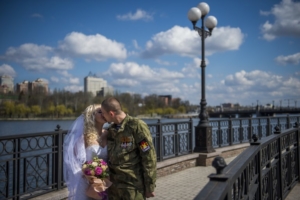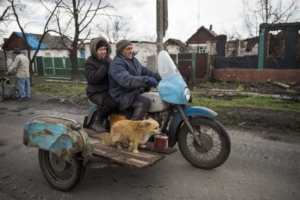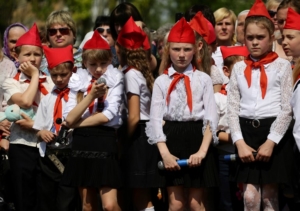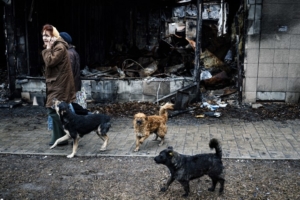A journalist from the online Russian-language magazine Spektr.press came to Donetsk to look for stories of those involved in the battle for Ilovaisk. He found none, and a territory seemingly dragged back in time to 1937 – the middle of the Great Terror in the Soviet Union.
“Ilovaisk” was my first completely unsuccessful project.
Obviously, any complete story about Ilovaisk in August 2014 would have to mention the first participation in the conflict of battalion and tactical groups of the Russian regular army. But Russia still lies about its involvement.
And who is going to talk about this in today’s Donetsk? The well-known Oplot and Vostok (Russian proxy units) didn’t participate in fighting for Ilovaisk – it was mostly the Russian Cossack formations that fought there. But in April and May of 2015 the Cossack units were forcefully disbanded by the Russians. Some of the fighters were killed, others were arrested, and still more were dispersed among various units. There are no more those Cossack groups. Those who are still fighting cannot be contacted, and those who went back to Russian have disappeared, and refuse to talk to journalists.
There are regular rotations in the Ukrainian armed forces – most people serve for a year, and so most of those who fought at Ilovaisk have long since been demobilized. In Kyiv, Dnipro, and Zaporizhzhiya veterans have stated their own businesses, and there are volunteer organizations and psychologists to help heal the former soldiers’ mental wounds.
And in Ukraine the losses are not a secret. The locations of graves are known. There is a complete and understandable narrative about the events of August 2014.
This story is shared in many interviews, the first books about the tragedy have been published, and military prosecutors have conducted an investigation. The story includes the infamous “green corridor” opened so that Ukrainian troops could escape encirclement, and which was agreed between Russian officers and Ukraine’s General Staff. And it includes the Russians’ shelling of this “green corridor,” causing mass slaughter.
DNA from the remains of fallen Ukrainian soldiers is being carefully studied in the morgue of Dnipro city, so as to match names to the hundreds of nameless graves at the local cemetery.
But how many fighters were killed on the Russian side? How many were wounded? Where are they buried? When will the secrecy be lifted? When will trying to discover the full story of what happened in Ilovasik not be seen as “high treason” or “spying?”

A picture taken in Donetsk on October 17, 2015, shows people walking past a portrait of Soviet dictator Josef Stalin on an advertising board. Three Stalin portraits hang in the centre of Donetsk, the main city held by Russian-backed separatists in eastern Ukraine, where a mood of nostalgia for the Soviet era is all-pervasive. AFP PHOTO
Sources in Donbas
A careful two-month investigation in Donetsk uncovered three potential sources who had participated in the battle.
The first, a group of people from Ilovaisk itself, didn’t even respond to requests for meetings.
The second group, which consisted of the three current fighters in Donetsk, initially agreed to meet if there was no video recording. Then they demanded no audio recording. In the end they refused to meet at all.
The third source was an elderly man from a small mining town who took part in the fighting. But her refused to meet because he didn’t want any “publicity.” He is no longer a fighter, and collects a Ukrainian pension. He regularly travels across the contact line, registers with Ukraine’s border guard service, and picks up his pension in the state savings bank, Oschadbank.
Sources in Russia
Perhaps it would be easier to interview Russian regular soldiers who participated in the Battle of Ilovaisk. Ukraine’s Prosecutor General’s Office, and the Centre of Military-Political Studies, a non-government organization, and its project Informational Resistance have published extensive investigations into the Russian army’s participation in fighting in eastern Ukraine in 2014.
According to information from the Ukrainian side, nine Russian battalion-tactical groups crossed from Russia into Ukraine on the night of Aug. 23 to Aug 24, 2014. The Ukrainian sources also have a list of the names of 36 killed and 161 wounded Russian paratroopers who fought in the battle.
According to those investigations, Russian veterans of the Battle of Iloviask could be found in Tula, Kostroma, Ivanovo, Novorossiysk and Pskov.
But in the more than three years since those events, no Russian army soldiers who fought in Ukraine have published their stories. And since 2014 information about military losses in peacetime has been classified in Russia. Soldiers have been ordered to delete their social media pages, and any publication that attempts to talk to the military meets a wall of resistance.
“Any attempts to talk with the soldiers of the airborne brigades have become very difficult since 2014, given both the attitude of the soldiers and their commanders,” Denis Kamaliagin, the chief editor of Pskovskaya Guberniya, a regional newspaper in Pskov, told Spektr.press.
“In 2015, the press service of 76th division of airborne forces ceased to exist, and its rather talkative then-spokesman Ruslan Kompanets left his job. Now the Ministry of Defense either contacts us directly from Moscow, or through the press service of the Western Military District. Anyway, talking to the official bodies of the defense ministry is pointless, because they don’t tell the truth.”
“Those who fought in Ukraine are even more reluctant to talk honestly,” Kamaliagin added. “First, because many of them are either still there (in the Donbas) or went to Syria, and many of them have died there. In November we reported the death of a member of the Wagner Group, a Pskov native, who also fought in eastern Ukraine. We then tried to contact his relatives, but they were very aggressive, telling us that they ‘much regret’ that this information was published. Moreover, father of this killed soldier was (a military) commander some 15 years ago. So we can understand his attitude to journalists.”
“In fact, those who could talk, who are potentially available and who don’t deny taking part in the war – they’re all still in eastern Ukraine. If they’re still alive, that is.”

Pro-Russian separatist Junga (war name) and his bride kiss on a bridge along river Kalmius after getting married in Donetsk on April 22, 2015. AFP PHOTO
Information gap
Given the huge information gap between Russian and Ukraine, any projects aiming to bridge that gap, to open a dialogue, are doomed to fail. And this is true not just of the topic of Ilovaisk.
Andrey Kamenshchikov, the coordinator of the eastern European network of the Global Partnership for the Prevention of Armed Conflict, once tried to organize a meeting of librarians from Russian, Ukraine and Belarus on Belarusian territory. The project failed, for reasons Kamenshchikov explains as follows:
“The problem is that both sides can’t even agree on the facts. Usually, regardless of different opinions, there is a common understanding of the facts, for example – both sides admit that the war exists, while they might have differing opinions about who is to blame for starting it,” he told to Spektr.press.
“But in Russia people even don’t realize the role that their state played in those events – they don’t realize that it was responsible for fomenting and supporting the war. Ukrainian society, for its part, knows more about war, and is highly traumatized by it. This difference makes it hard to start any dialogue, because people from the different sides see reality so differently.”
So now is still a time of monologues, and silence.
Journalists in Donetsk
How do journalists work in Donetsk? In the Russian-occupied part of Ukraine’s Donetsk Oblast, the self-described “DNR,” there are two forms of press accreditation – civilian and military. Civilian accreditation prohibits journalists from working in the war zone or at the military facilities. It is issued by the local DNR press service, with the journalist being vetted by DNR’s security service and foreign affairs ministry. Military accreditation is sent for approval by “curators.” It is not hard to guess who these “curators” are, and where they are based.
The staff of the ministry of foreign affairs of the self-proclaimed republic is mostly occupied with reading stories and watching videos produced there by foreign journalists. At least they used to be.
The number of foreign reporters in this area has decreased drastically since the winter of 2015-2016, when the authorities stopped issuing accreditation to them.
The last big influx of foreign media was on the first anniversary of the downing of Malaysia Airlines Flight MH17 in July 2015. Now the occasional foreign journalists comes, alone, having obtained permission from the Finnish propagandist Janus Putkonen, who heads the “republic’s” English language news agency.
“He demands that journalists are as sympathetic as possible, and that the use frequently the DNR abbreviation (to describe the Russian-occupied part of Ukraine’s Donetsk Oblast),” a source who helped several journalists obtain accreditation from Putkonen told Spektr.press.
“He prefers freelancers who have never been to Donetsk before, because they haven’t seen the situation there develop, often they don’t speak Russian, and you can just drive them to destroyed towns and show the people suffering here and now.”

A couple and their dog ride a motorbike with a side-car in the village of Nikishino on April 21, 2015 in the self-proclaimed separatist republic with the center in Donetsk. AFP PHOTO
Russian journalists
Only journalists with Russian passports dare to work here without accreditation.
One of them is Pskovskaya Gubeniya’s Kamalygin. Kamalygin arrived in Donetsk on March 10, 2016, and on March 13 officers from the MGB (the “ministry of state security” of the “DNR” detained him in a hostel, destroyed all the information on his electronic devices, and after interrogation took him to the Russian border.
“You know, I still have no idea how they managed to find me,” Kamalygin told Spektr.press
“The administrator of my hostel was surprised by my arrest, because she didn’t know I was a journalist. I hadn’t published any story from there before my arrest. I had only asked my hostel neighbor – an insurgent – about his life. Maybe it was he who reported me?
“They didn’t beat me. They treated me fine. On my return, I published three stories from memory, as they had erased all they could from my phone, audio recorder and flash disks.”
Everything under control
Just under 30 percent of the pre-war territory of Donetsk Oblast is under Russian occupation. However, the law enforcement agencies of the self-proclaimed republic are staffed with enough officers to cover the entire oblast. Everything would be under control on this small territory even without a network of agents. But there is also a network of agents, and the results are remarkable.
In May 2017, I interviewed Alexander Khodakovsky, the former chief of the “DNR Security Council,” and quite by accident overheard a story about two journalists from Moscow who had had all the necessary accreditations.
These officially registered Russian journalists had been given a special monthly tariff at a hotel – 4,000 rubles (about $70.) It was not much in comparison to prices in Moscow, and the journalists paid it. But after only a week they were urgently called back to their newsroom, so they packed up their stuff and headed to the border.
A hotel staff worker found this quick departure from the already paid-for hotel room very suspicious, and reported it to the MGB. The trip from Donetsk to the Uspenka border crossing into Russia takes only from one-and-a-half to two hours, but the journalists were caught up with, detained and arrested. It took another two days to resolve this misunderstanding, after Khodakovsky’s personal intervention -either the colleagues or the wives of the detained journalists contacted him.
There is no way for a journalist to work seriously in Donetsk without accreditation. Local people are resistant to talk to strangers. When they talk to journalists they always check their IDs. Moreover, all aspects of life in the “DNR” are rife with law enforcers and public sector workers. When working in any city, your ID will be checked minimum three times. There is always a special attention and sometimes even aggression to a person with a camera. And these problems emerge during the work just on the civilian topics.
When you try to find out some information from the military, either current or the former ones, it would be another story.
Cactus breeder accused of spying
Three big men knock to the ground a skinny men in glasses, who is wildly screaming at that time. They order him: “Quiet, quiet, quiet!” Get up carefully!!!” These is an arrest of a man accused of pro-Ukrainian views and spying at the territory of DNR — a non-recognized statelet with the center in Donetsk.
Then the arrested man admits in front of the camera that he is “a Ukrainian citizen, who considers himself a Ukrainian patriot” and who was posting on Twitter in 2015 “information about movement of the armoured vehicles and soldiers in Donetsk and also was posting the photos of them when it was possible.” Then the arrested man admitted that he exchanged letters with the Twitter user called “Stop Terror” and gave assessments of the “military, moral and political situation” in Donetsk on his request.
This man looks like a typical cartoonish nerd (in Russian a botanist) — he’s not athletic, scared, smart and wearing glasses. Indeed, Yuriy Shapovalov is a staff worker of the Donetsk Botanical Garden and is also known in the city as a head of a local club of the fans of cactuses.
The arrest of the cactus breeder Shapovalov was the last big catch of MGB DNR (the local security police), which posted a video with Shapovalov’s “confessions” on the official site of the agency on March 7.
Now Shapovalov is facing from 12 by 20 years in prison for “spying.”
“We don’t have the acquittals with the charges like this,” told me a source from the DNR’s justice system. “The are usually being prepared for exchange. Sometimes they are being convicted very quickly. Your friend will also likely be used for the exchange.”
Spying though the dashcam
My friends are one couple. A businessman Andrey Kochmuradov and a doctor Elena Lazareva disappeared in Donetsk along with those private cars on Oct. 17, 2017. In a month of the fruitless search, Andrey’s mother received a response from MGB saying that the couple was brought in custody for 30 days according to the “decision of the Council of Ministers of DNR for immediate measures on defending people from banditism and other ways of the organized crime.”
This decision was issued in August 2014 and according to it any person living in the unrecognized republic may be brought to custody for 30 days “for reeducation.”
I know about several cases like this. But Andrey and Yelena were not released in 30 days on Nov. 16, 2017. On Dec. 7, 2017, MGB DNR published a video with those “confessions.”
According to MGB, this couple while being at a checkpoint agree to cooperate with SBU (Ukraine’s state security service) being threatened of criminal prosecution for having a dashcam in those car. Elena allegedly was taking pictures of the clinical records at her work place while Andrey delivered to SBU the client base of the internet provider for which he worked for.
In fact, Ukraine’s criminal legislation, as long as Latvian or Russian ones, don’t ban using the dashcams in the cars. So a criminal case for a dashcam is nothing more than a joke.
Moreover, for nearly four years of war I’ve seen a dashcam in Donbas only once. It was on a bus Donetsk-Yasinovataya in February 2018. The bus driver explained me using a dashcam by the fact that they had no checkpoints on the way. “But there are many stolen cars, they break the rules very often, that’s why I risked to install it,” he said.
Of course in 2014, nobody with a dashcam in the car was able to pass a checkpoint. It would be removed at least to view the video records of the enemy checkpoints. That’s why people in the war zone never use the dashcams driving through the checkpoints.
Top secrets everywhere
This is no sense to argue about the “values for the intelligence” of photos of the clinical records of the wounded soldiers — in DNR these records have only the nicknames — or the value of the client base of the internet users. In the self-proclaimed republic any information regardless of its value is a state secret, for which a person may be brought to jail or expelled.
Any information about killed or wounded, any economic data, any budget numbers, any information that could be deemed as socially-political is a state secret.
That’s the way how the allegedly “intelligence” organization Doctors Without Borders was expelled from there. And the Chech foundation People in Need, Catholic charity Caritas and the Danish Refugee Council were banned.
Any western foundation requires its local staff to collect the reports about delivery of the humanitarian aid. But these reports could be called a collection of “the classified information about the social and economic situation in the republic.”
So for now only the humanitarian agencies of the United Nations and the International Committee of the Red Cross keep on working on the territory of DNR thanks to some backroom deals. All the other non-Russian humanitarian organizations were expelled.
That’s why there’s no point in trying to prove the “spies” in Donetsk were not guilty.
Anybody could be arrested on any charges
“We are all victims of information war,” told me one well-known doctor and administrator in the DNR’s medical system.
I was trying to understand when talking to him why the medical community don’t react of the arrests of those colleagues.
Elena Lazareva is a doctor with 27 years of experience at a special neurosurgical clinic of intensive care at the Kalinina Regional hospital. Now all the surgery clinics in Donetsk function as the military hospitals. The surgeons and surgical nurses are the most valuable medics in times of war. Unlike soldiers, they could not be trained just in one year.
My former colleagues — before becoming a journalist I worked at the same intensive care clinic after finishing Donetsk Medical University — were telling me until winter 2017 that the secret services didn’t touch the hospitals, realizing that the doctors keep on doing those professional work according to Geneva Convention, which protects medics at war.
But now I could easily find the two more fresh cases of arrest the Donetsk doctors “for spying.”
Life in Donetsk teaches that anybody could be arrested on any charges.

This photo taken on May 26, 2016 shows children in red caps and ties, inspired by the Soviet Pioneers movement, taking part in a meeting of the youth movement “Patriot” in the outskirts of Donetsk.
Youth movements are only one example among many of this infatuation with the Soviet past. A least a dozen of them are now listed in the self-proclaimed statelet with the center in Donetsk.
/ AFP PHOTO
Is this 1937?
There was a telling story of the DNR ministry of fuel and energy. Its ministers were the weakest part in the entire government. The first one was the fuel and energy minister Aleksey Granovsky in 2014. He spent four months in detention, then left for Russia, then he returned and became the “head” of Debaltseve city and then he became a head of the current ministry of industry and trade.
Then minister on fuel and energy Evgeniy Fainitski was arrested in 2015 and died in custody. Ruslan Dubovsky, who replaced Fainitski in 2015-2016, was luckier and quietly left his post. But on Feb. 27, 2018, minister of fuel and energy Eduard Golenko was arrested along with some other officials. On March 13, there was the fifth minister on fuel and energy who started his job.
When I discuss this with people outside of DNR in Moscow, Kyiv or Riga people react the same way. “Is this 1937!?”
Not at all. In 1937 Soviet people didn’t live under a curfew, but they also didn’t have the access to the alternative sources of information and couldn’t freely travel to the enemy area.
There are no Ukrainian TV channels in Donetsk cable networks. The web-providers have a list of the banned Ukrainian websites and of course these territories don’t have Ukrainian newspapers or radio for a long time. But hundreds of thousands of people cross the separation line every month and learn about the situation in Ukraine. Despite all the bans, there is still an access to social networks in Donetsk. And there’s always an option to resettle to Russia or the government-controlled part of Ukraine. And live there in an unknown city, in a rented flat.
Restaurants and curfew
Restaurants are the special area here. There are no more sports bars in Donetsk because it’s impossible to organize watching the games of the League of Champions of other football matches — they all end up usually after 10 pm. The curfew starts at 11 pm and lasts until 5 am. Over the years it has become more habitual and more strict.
“I have been twice caught by the police for violation of the curfew last year,” one Donetsk resident called Sergey told me. “They just bring you to a police station and you sit there in a corridor, sometimes by 4:30 am. There’s nothing good in it!”
In the restaurants, the waiters start massively deliver the bills at 9:30 pm and the customers and staff start a mass “evacuation” at 9:45 pm. The taxi drivers also have to get home in time. So it could be impossible to order a car after 10 pm.
People try not to discuss politics with the unknown people under the table and of course don’t discuss anything by the phone. Many locals believe that the secret services also “read” the web messengers.

A pack of stray dogs follow women walking past a a burnt out shop in the Kievsky district of the eastern Ukrainian city of Donetsk on April 2, 2015. With heavily-armed men patrolling the streets, shootings in the dark of night and the echo of gunfire from the airport, life is far from normal in the east Ukraine city of Donetsk weeks after the signing of a ceasefire. AFP PHOTO
Life with limitations
Current life in Donetsk is a conscious choice of life at home with some limitations, which people tend to ignore. “I’m afraid of nothing in Donetsk!” tells me my friend firmly while welcoming me at his house.
And then he gets angered seeing the browsing history in his little daughter’s tablet with some Ukrainian websites there. “Who did open Ukrainska Pravda, Obozrevatel and Texty here?! This is dangerous and stupid!”
When we discuss that children have to stop studying Ukrainian and have to attend the lessons of citizenship in DNR, q wife of my friend sadly smiles: “We all used to be the Soviet pioneers.”
When we speak about the need for all the public sector workers join a civil organization called Donetsk Republic, they tell me — well, then we have to do this.
When it goes to the requirement to sign a plea of not going to the “territories occupied by Ukraine.” Then, they ask me, where is a place to put a tick?
Someone checks my papers at all the local public events. With my journalistic custom to walk alone in a crowd, listen to the conversations around me, to look into people’s eyes trying to catch those emotions, I can be easily detected in the crowd. People try not to look here in the eyes of people wearing camouflage, abide to all the orders, avoid being noticed.
If a person looks not on the ground he draws attention.
